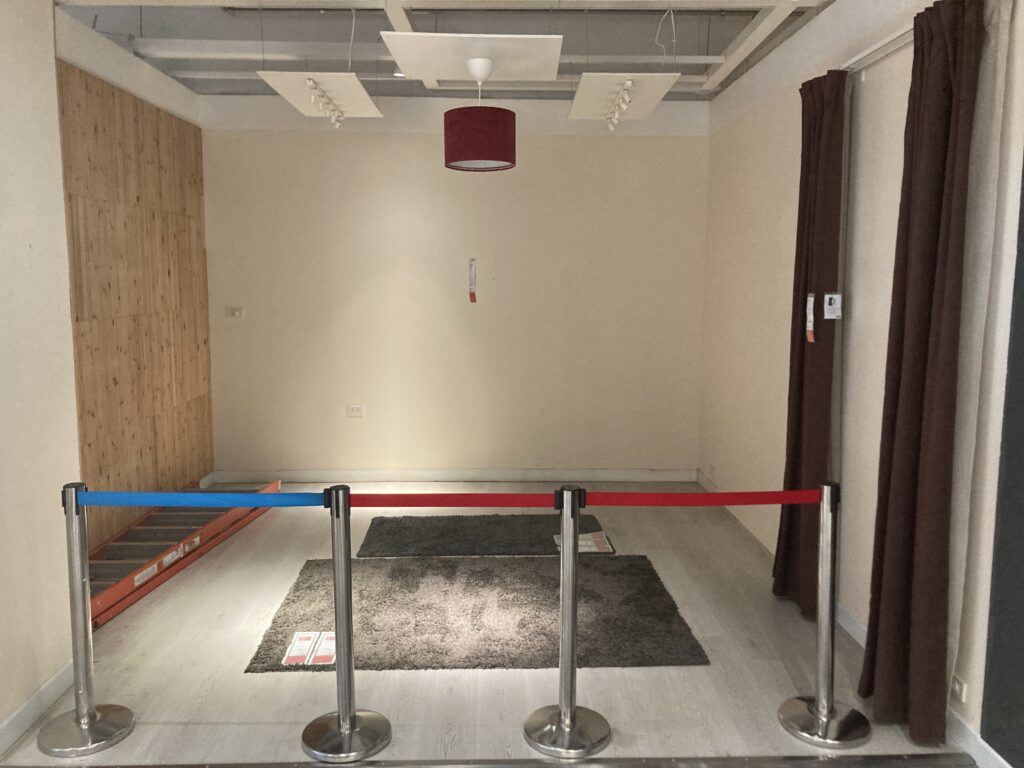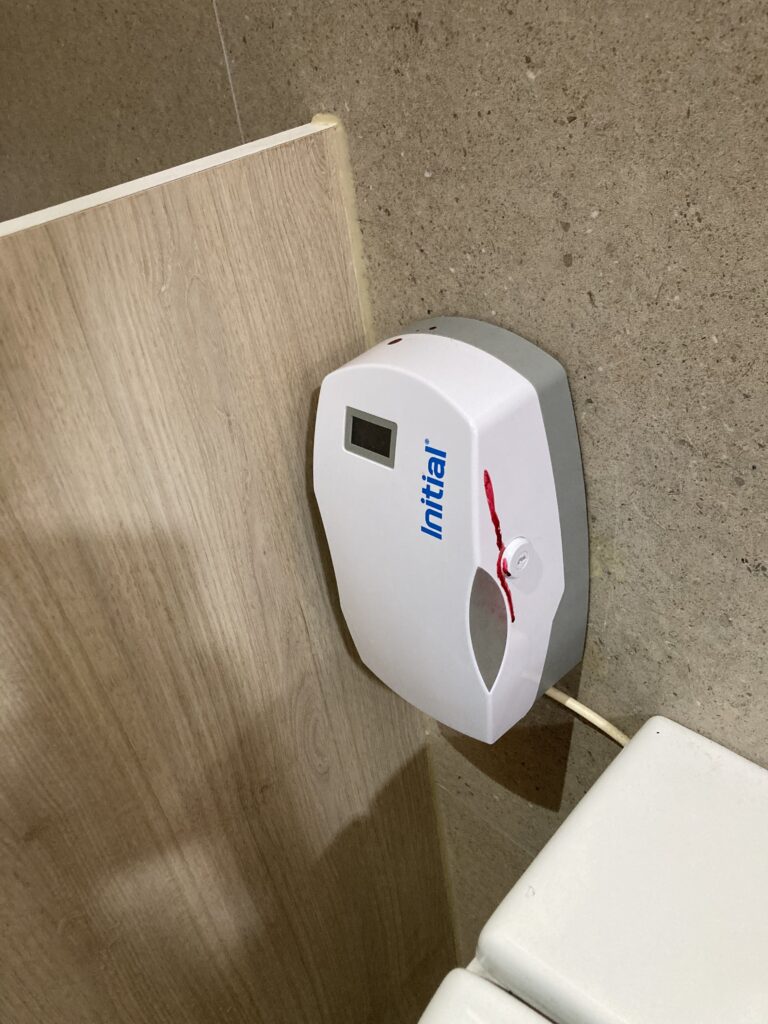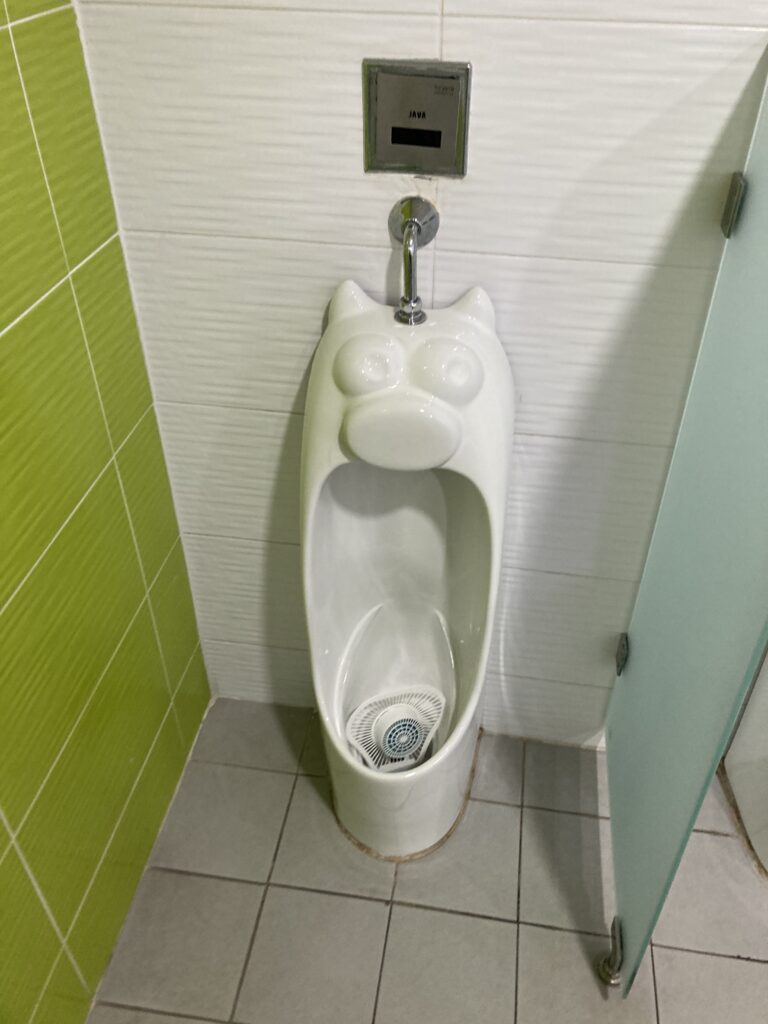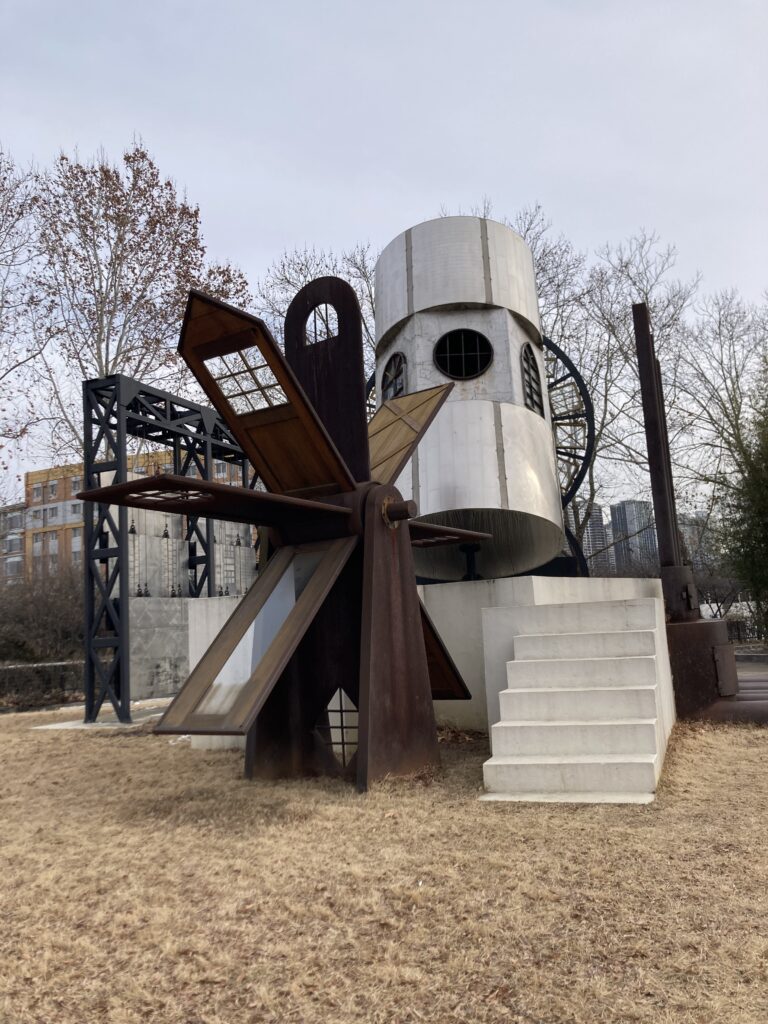display

The traveler explores the American Wayside, verifying the contents of a mysterious guide written by a man with whom he shares a likeness and name. Excerpts from ‘Autumn by the Wayside: A Guide to America’s Shitholes’ are italicized. Traveler commentary is written in plain text.

“Hello, my name is Midrigar and I will be your server today. What can I get you?”
The man standing next to the table is young. ‘Midrigar’ is an approximation of his name, which was more a sound, really. A sound like a boulder rolling down a hill. I try to check his name tag but the symbols on it hurt my eyes.
Midrigar sees me squinting and covers the tag with his hand. “Sorry about that. If it’s easier, you can call me Mike.”
With my eyes released from the quivering letters on the man’s chest, I see that one of his eyes has rolled back up in his head. The iris reemerges from the bottom after a complete spin. An ocular sunrise that makes me want to vomit. “It seems important to call you by your real name… Midri…” My tongue becomes sluggish in my mouth. Blood pours up from my throat and I spit it into my coffee while I pretend to take a sip.
In the booth ahead of me, a mother snatches a child’s menu away from her son. He had been connecting dots and the result is a multi-pointed star that glows black. A man facing the corner of the restaurant and standing still as a statue disappears as she crumples it. The boy begins to cry.
“Midrig…” A car alarm goes off outside. Something small and reptilian briefly surfaces in my coffee. “Midriga…”
Midrigar sniffs and waves his pen at me. “Just order.”
‘There are things out there that are not human. Spirits. Demons. Monsters. Some, among these entities, see their inhumanness as an affront and seek to change to change it. They take what they want. They possess.
Then they find out what it is to be human and those that don’t seek out a violent end usually make their way to ‘Cal’s Place.’
‘Cal’s Place’ is a café that employees possessed humans that, due to personality quirks or the physical modifications to their host’s body that occurred as part of the possession, are unable to find work elsewhere. This demographic serves as the main draw of ‘Cal’s Place,’ which is otherwise known for mid-ranged food and less-than-ideal customer service. Customers arrive at the café well aware that their hosts and servers will occasionally skitter across the floor on limbs that bend backwards or utter words that shake the tables and cause those with sensitive minds to briefly black out.
The employees put up with the indignation of being photographed and recorded for social media because there are few other solutions available and, unlike their previous vague and immortal forms, their human bodies need to eat to survive.
As of 2025, possession remains unrecognized as a qualifier for any sort of government aid, though host bodies are sometimes stripped of their assets in situations where courts have ruled their identity has technically ‘changed.’ Advocates for human hosts tread lightly, aware that legal recognition of possession may just as likely result in prosecution as protection. The system is always looking for more prisoners.’
– traveler

‘Undulating’ is the word that best describes the floor of ‘The Dance Factory,’ a venue for young and inspiring influencers to produce content in an environment designed explicitly for that purpose. The influencers, who I assume pay through the nose to be on the floor (the actual pricing is discussed during in-person meetings only), move below the area meant for visitors, like me, who pay slightly less, but still quite a bit, to witness the whole thing in action.
We are not allowed to record, for obvious reasons. This would be like snatching wieners from the water vat at the hot dog factory. The sausage doesn’t belong to us. We might get hurt trying to take it. The meat isn’t even finished. It might make us sick.
So we watch, from out bird’s eye view as people perform careful dances or stunning displays of parkour in rooms meant to look like other places entirely. A man reclines in the first class seat of a common airplane. Another brings his phone close to a dinner he’s eating in the capsule-style sleeping room of a cross-country train.
The group I’m touring with is random and diverse, but among them is a teenage pair- brother and sister, I think, or boyfriend and girlfriend. Not my business. What is sort of my business is the context they bring to the visit. Our guide only speaks about the facilities, which, I suppose, is why I’m here. They talk non-stop about the people below us, minor celebrities and frenemies with beef. Twice, the tour guide has to ask them to refrain from calling out to people they recognize. The teens want so badly to be on the floor that I want it for them. Passion is healthy, right?
When I catch a glimpse of myself in the glass, I remember I’m not the image of respectability. That my life has gone off the rails for something that may have been passion, once, but is now an entrenched duty with no purpose or end. The rails seem fairly distant now. I’m not sure my wheels would even sync to the tracks.
‘There are numerous instances of stupid people digging where they shouldn’t and being rewarded with oil or buried treasure or labyrinthine tunnels with historical value. With much of the earth churned already, those happy accidents occur with a bit more subtlety, and ‘The Dance Factory’ has all the tells.
The name, for instance, was clearly chosen by somebody of a generation that is far removed from the zeitgeist. It is neither edge, nor wholesome, nor even ironically ‘cringe’ enough to be a business associated with Gen Z or younger, and this checks out. The owners are boomers, already rich from being born at the right time and with the right skin color. In the few interviews they’ve agreed to, Michelle and Leon Tach express the good sense that the further they are away from the operational side of ‘The Dance Factory,’ the better. They would ruin the ‘vibe,’ Leon is quoted as saying, and the word ‘vibe’ exits his mouth with the same polite distaste of a man who has only recently tried sushi and found he prefers his fish cooked.
The Tachs are quite comfortable in acknowledging that some of the content produced at ‘The Dance Factory’ is questionable. They justify the output by indicating that the far-left and the far-right political banter made, there, is equivalent in volume and that it’s all largely drowned out by the fluffy dance stuff and the ASMR that sometimes borders on erotic.
Leon shivers at this. “Can’t stand the whispering stuff,” he says, “Give me the dance over the whispers any day.”’
In the basement of ‘The Dance Factory’ there is a room with the exact dimensions of the one above, the one with the facades. This is a quieter room, a place with cubicles and ample charging stations and some nice looking computers that go largely ignored. Here is where the influencers go to cut and edit the content that, in its final form, appears effortless.
“Still think you want to go into this line of work?” The father of the teens is frowning through the window. He strikes me as the sort of man that works in an office like this.
The teens nod and the tour ends at a mandatory gift shop.
-traveler

Well, I suppose it’s been on my list for a while- one of those places that sort of has to find you rather than the traditional vice-versa. For all the time I’ve been out exploring the Wayside, I’ve managed to avoid ‘The Dead End’ until I came upon it accidentally a couple days ago, having turned left in one of those really quaint neighborhoods where the roads tend to meander rather than run straight because they all have the land to accommodate aesthetics over efficiency. That left took me up a near-single lane street, past a few houses, before I came to ‘The Dead End.’
Before I came to it the first time.
‘Beware ‘The Dead End,’ which has terminated the trips of several promising travelers. It is a place with many entrances and very few exits, and it traps visitors at random, then releases them in far few numbers.
‘The Dead End’ can be avoided with a little care. Some travelers reject modern GPS navigation but this is your primary method of prevention. ‘The Dead End’ only manifests in established dead-end roads, meaning that a device, operating with the latests information, should be able to steer a vehicle away from anywhere that might possible serve as an entry point. There have neen no reports of temporary closures due to weather or construction spreading ‘The Dead End,’ though detours provide ample opportunity to confuse a traveler, and to point them toward ‘The Dead End.’ When in doubt, it behooves the traveler to pull over- to stop in the road, even- rather than proceed toward ‘The Dead End.’
Understand that this advice is meant to serve as a guide rather than a guarantee. The only true method of avoiding ‘The Dead End’ completely is to stay home, but that would be tantamount to the same thing.’
I imagine if I came to a barrier and dead end sign in the middle of the freeway in any other context, I would have been confused and maybe scared. Maybe I would have plowed right through, having been midway to reaching something dropped on the passenger floor, fully comforted by the knowledge that highways and interstates can take me many places but basically never to full, unexplained stops.
But it was dark when I arrived here, at the latest manifestation of ‘The Dead End,’ and I was already suspicious from a day of ‘accidentally’ taking wrong turns every half hour or so. The cherry on top was having to reverse down a one-way street for several minutes before backing into an intersection for a hurried three-point turn, before getting back on ‘the right track’ and immediately running into a new dead end street.
Now, even my GPS tells me there are no known paths forward, only a series of blockages. Some close by. Some a few miles out. I set the GPS to my home address for the first time in nearly a decade and I receive the same results, only the dead ends are closer now.
No way forward.
No way back.
I U-turn and head back toward Cedarville, the nearest town. Halfway there I come to a point where the shoulder and the land beyond seems flat for a while and I carefully navigate the camper off the pavement and onto the ground. The suspension struggles with the sudden change in terrain, but I carry on, hoping that the earth won’t shake my home to pieces. I cut across the field and squeeze through the trees beyond and drive over more grass, turning to make my way up the shallowest hill and then back down. The camper threatens to topple several times, but soon I see a new road ahead. I pull on, and reset the GPS. After a minute, it confirms.
I’ve shaken off ‘The Dead End.
Home, from here, is only an hour away. It’s very tempting, suddenly. More tempting than it has been in a long time. Still, I shake my head and check the guide and input a new address, this for a place called ‘The TikTok Factory.’
Can’t imagine this one will be my cup of tea, but I don’t have it in me to complain. I turn on the radio, and go.
-traveler

‘The common sentiment about ‘The Second Location’ is that it should be avoided at all costs, particularly if somebody is attempting to take you there and certainly if that person is a stranger. The author, here, would like to endorse the traveler’s gut in these situations, understanding that it will rightfully sense danger in places like ‘The Second Location’ and in the regulars who hope, so often, to bring guests. The author extends, also, a caveat to the previous statement, suggesting merely that ‘The Second Location’ has received an undeserved reputation from those who have abused its relative isolation in the past, and that there is much to like about ‘The Second Location’ for those that approach it free of ill intent.
It’s just that you never hear from the people who liked being taken there.’
-an excerpt, Autumn by the Wayside

‘Previously (and still technically) called ‘Lake Wells,’ ‘Lake Slime’ was, some years ago, infected with a European strain of algae that has absolutely thrived in its new home. This algae has transformed the water into a sort of gel- a slime- that has proven resistant to the (admittedly limited) attempts to eradicate it. The high water-content of the slime makes it resistant to heat and fire. Chemicals tend to slide off the surface of the slime, poisoning the wildlife around it. Actually solving the problem would prove to be complicated and expensive.
And, for the most part, the algae’s damage is done. The fish in the lake died and were pushed to the surface for birds to pick at. The surrounding animals proved willing to, for lack of a better word, chew their water and nature adapted. The only downside proved to be a sharp decline in the recreational value of ‘Lake Wells.’
Then, a video emerged of a local teen running across ‘Lake Slime,’ relying on the slime’s non-Newtonian viscosity. Comments on the video, which soon went viral, pointed out that the depth of the lake reached 20’ at its center and that swimming in the slime would prove difficult or impossible if, say, the same teenager were to trip halfway across. This only exasperated the virality of the video. Copycats proved the stunt could be performed again and then one would-be copycat, a thirty-year old family influencer from several states away, drowned in the exact manner laid out in those early comments.
‘Lake Slime’ is closed to the public but, like the attempted eradication of the slime, those barriers and signs installed to actually keep the public out seem inadequate compared to the situation beyond and the viral pull of possible celebrity.’
Despite the relative fame of ‘Lake Slime,’ its distance from anything else of interest seems to do a better job of keeping visitors away than the waist-high fence and finger-wagging signage that suggests danger past a certain point. Credit should be given to the artist of said signs, however. Given the task of illustrating the theoretical demise of an influencer in a lake of slime with blocky shapes in yellow and black, they have risen to the challenge. A stick man, with a backward baseball cap, screams for help as someone films with their phone from shore. The man’s up to his chest, past the point of saving, I’d guess, even if the audience (here represented by just a phone-in-hand) took up a rope and attempted a rescue.
Which they haven’t.
It’s stupid, to think that crossing the lake is a good idea, but here’s the thing, reader. My sense of what it means to have experienced a destination is vaguely defined, sometimes leaning into the danger of a place and sometimes leaning away. I don’t know until I feel it and, when I arrive at ‘Lake Slime,’ I know, almost right away, that I will have to attempt it myself to feel justified.
It’s not an ideal way to be.
On my side is ample evidence of this being possible. Sure, one man tripped and fell, but there are countless other videos of people heavier than me taking the lake at something like a fast walk- of becoming so confident that they do a few circles in the middle, holding their hands out to either side and grinning at their videographer as if to say, See? This is easy.
They make it look fun, and while I don’t intend to have fun, it seems ridiculous to me that someone could have fun doing something I wouldn’t even attempt due to fear. Not here. Not on the Wayside, where I’ve made my home.
So, I check the laces on my boots- tied, but not so tight that I won’t be able to abandon them to the slime for a second chance at escape if I start to sink. I set my backpack on the shore and stretch, maybe for the first time in my life. I throw a rock out into the middle and watch it sink slowly below the surface, hoping it will make me feel better about what I plan to do (or so poorly that I change my mind). It has neither effect, so I remain in the position of knowing I’m about to do something stupid.
I step back and take the slime at a running start. It bounces underneath my steps, propelling me forward such that I worry I’ll topple, but then I embrace the speed it gives me and my pace stabilizes and suddenly I’m walking on water.
The Wayside can be playful, the way a cat is playful. Willing to show its belly. Happy to bite when it’s finished being stroked. I play, for a while, and I stop when I know it’s time. We’re familiar, now, the Wayside and I. Not friendly, maybe. But familiar.
-traveler
© 2024 · Dylan Bach // Sun Logo - Jessica Hayworth